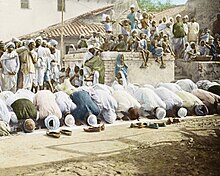
Back مسلمون بهاريون Arabic مسلمين بهاريين ARZ বিহারী মুসলিম Bengali/Bangla مسلمانان بهاری Persian बिहारी मुसलमान Hindi بہاری مسلمان PNB Bihari Muslims SIMPLE بہاری مسلمان Urdu 比哈爾穆斯林 Chinese
 Muslim men praying in Siwan district, Bihar, 1910 | |
| Total population | |
|---|---|
| c. 24,538,379 Million | |
| Regions with significant populations | |
| 23,138,379[1][2][3][4] | |
| 1,000,000[5] | |
| 400,000[6] | |
| Languages | |
| Urdu, various Bihari languages[7] | |
| Religion | |
(Sunni majority, Shia minority) | |
| Related ethnic groups | |
| Other Biharis | |
Bihari Muslims are adherents of Islam who identify linguistically, culturally, and genealogically as Biharis. They are geographically native to the region comprising the Bihar state of India, although there are significantly large communities of Bihari Muslims living elsewhere in the subcontinent due to the Partition of British India in 1947, which prompted the community to migrate en masse from Bihar to the dominion of Pakistan (both West Pakistan and East Pakistan).[8][9]
Bihari Muslims make up a significant minority in Pakistan under the diverse community of Muhajirs (lit. 'migrants'), and largely began arriving in the country following the Bangladesh Liberation War of 1971, which led to the secession of East Pakistan from the Pakistani union as the independent state of Bangladesh.
The majority of Bihari Muslims adhere to the Sunni branch of Islam and the adoption of the religion by Biharis traces back to the 14th century, when Afghan traders and Sufi missionaries began to arrive in the region a century prior to the Mughal Empire's conquest of the subcontinent.[10] There are also a significant minority of Biharis who adhere to the Shia branch of Islam, largely residing in Patna and Gopalpur in Siwan, tracing their religious descent to Shia Muslim settlers of distant Persian ancestry from Lucknow in neighbouring Uttar Pradesh, who arrived in the region during the 19th century.[11]
- ^ Joy, Shemin. "Caste survey in Bihar: OBCs, EBCs make up 63.13% of population; Gen Category 15.52%". Deccan Herald.
- ^ "Bihar Caste Census Population, Religion-wise Population & more". RajNeetPG. 3 October 2023.
- ^ "India's religions by numbers". The Hindu. 26 August 2015. ISSN 0971-751X. Retrieved 4 January 2020.
- ^ "Census of India Website : Office of the Registrar General & Census Commissioner, India". censusindia.gov.in. Retrieved 4 January 2020.
- ^ Arshad, Sameer (5 November 2012). "Will Nitish's visit boost Biharis in Pakistan?". Times Of India.
Abdul Kadir Khanzada, who represents Orangi Town in Pakistan's parliament, said he would like to welcome Nitish to his constituency, where a majority of over a million people have their roots in Bihar.
- ^ "The neglected 'Bihari' community in Bangladesh". Deutsche Welle. 14 January 2019.
According to local NGOs working for Bihari welfare, around 400,000 members of the community live in camps in Bangladesh.
- ^ "Case of Bhojpuri and Hindi in Mauritius". lexpress.mu. 27 July 2007. Archived from the original on 27 September 2016. Retrieved 26 September 2016.
- ^ Khan, Engr Imtiaz Alam (15 December 2019). "HISTORY: THE FALL OF DHAKA FROM BIHARI EYES". Dawn. Retrieved 4 May 2021.
- ^ Sajjad, Mohammad (13 August 2014). Muslim Politics in Bihar: Changing Contours. Routledge. ISBN 978-1-317-55981-8.
Others got attracted to the supposedly greener pastures in West Pakistan. Hence, in Karachi, a separate Bihari colony of construction labourers came into existence even before Pakistan was formally created. ... Moreover, some of the wealthier Biharis migrated towards West Pakistan. In order to induce further migration, Maulana Abdul Quddus Bihair, Chairman of the Bihar Relief Committee (Karachi) and also of the Jamiat-ul-Ulema-e-Islam began propagating that there was a better scheme of land and flats to be given to them in Karachi by January 1947. Quddus presented the province of Sindh as a destination that offered openings for traders, cultivators, labourers, contractors, manufacturers, weavers and professionals, and therefore was the 'best substitute for Bihar'.
- ^ Prasad, Ram Chandra (7 November 1983). "Bihar". National Book Trust, India – via Google Books.
- ^ Chaturvedi, Ritu (7 November 2018). Bihar Through the Ages. Sarup & Sons. ISBN 9788176257985 – via Google Books.